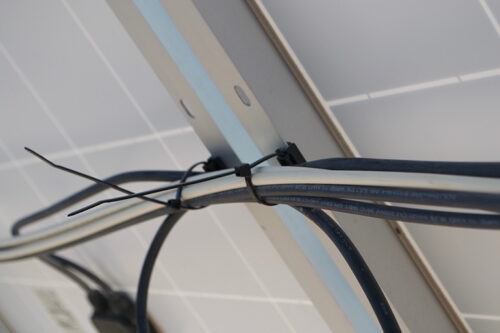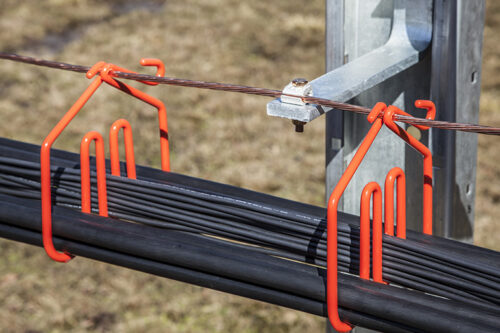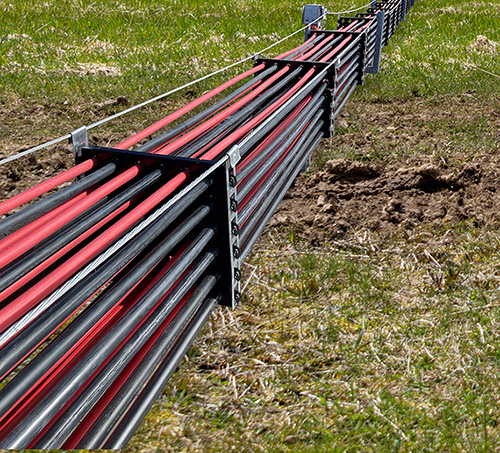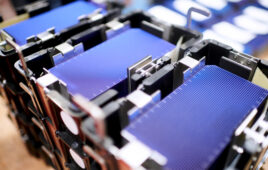
A worker from Knobelsdorff Enterprises tackles wire management for a large project.
Managing the wires that carry solar power from modules to inverters may be a small fraction of the cost of building large-scale projects, but taking the time to choose the right solution can pay dividends. Manufacturers are quickly engineering wire management solutions that fit with the latest racking, tracking and module developments.
“There’s lots of great products and options out there and there’s kind of that right fit for each site and customer,” said Karl von Knobelsdorff, president and CEO of solar EPC Knobelsdorff Enterprises.
The most popular above-ground management strategies for contractors are bundling wires or using cable hangers, but within those categories are many variations.
Bundling wires
When a solar installer decides to bundle wires using cable ties, it’s important to choose products that can withstand the elements. HellermannTyton is one such manufacturer that uses UV- and heat-stabilized plastic instead of coated metal to ensure cable ties don’t cut into wires and cause shorts.
“We really believe that full polymer-based wire management products are best for the market, and if you are using a metal product, it needs to be really thought out and application specific,” said Nick Korth, market development manager for energies at HT.

HellermannTyton’s module mounting hole wiring solution.
HT takes a custom approach to wire management, designing parts that work well with specific racking and module brands. The company makes ties and clamps that are threaded through unused module mounting holes on the racking, which can then be used to string wires through safely. Korth said it’s crucial to install that extra part rather than stringing wire directly through the module hole, which is sharp and could cut cable.
Installation is an important consideration in HT products. Even though stringing wire isn’t as strenuous a task as driving piles and lifting modules, it’s one that workers must repeat thousands of times on large sites.
“If you’re putting it on 50,000 times over the course of two weeks, your thumb and your fingers are going to be hurting if that’s a really high insertion force,” Korth said. “We design our parts so that they’re super easy to push on. The ergonomics are literally a part of every part that we design.”
Cable hangers
Another popular wire management method is using cable hangers to route wires around the site. Snake Tray, CAB Solar Cable Management and Affordable Wire Management (AWM) all sell such hanger products, each with a differentiator.

Affordable Wire Management’s aluminum wire hangers.
AWM’s products are aluminum hangers hung from a messenger wire. Hangers can be customized to allow for different spacing requirements between the bundles, different cable sizes and other configurations.
“It’s a highly customizable solution. It’s also very strong, so your cable hangers are spaced typically one every 4 ft instead of the typical one every 2 ft,” said Scott Rand, founder and CEO of AWM.
That flexibility means fewer hangers are needed on each site, saving on cost and installation time. The metal product is also durable, with a lifetime of 35 to 40 years, according to Rand.
CAB also uses metal in its cable hangers, but the steel is coated with thick PVC to protect the cables from sharp edges. CAB’s solution is unique because it uses a copper-clad messenger wire that acts as the electrical grounding conductor.

CAB’s grounded messenger wire solution.
“By combining the grounding capability in with the cable management, it just saves [contractors] money in the labor cost and on the product cost,” said Tim Wedding, solar program manager at CAB.
The company offers over 50 standard designs to support different combinations of bundles and other cables, and also makes custom configurations when necessary. Those designs include torque tube hangers that secure wires on tracking systems.
Manufacturer Snake Tray carries both metal and plastic cable management devices for utility-scale projects. The company’s products are different from other cable hanger options because they operate in “free air” — meaning each cable is separated and surrounded by air to avoid potential heat buildup from bundling wires.

Snake Tray’s “free air” wire management system.
“If we can keep an electron from crashing into another electron in a feeder system, we prevent heat,” said Roger Jette, president at Snake Tray. “And if we prevent the heat, the electron gets through the meter and the investors get return on investment.”
The company’s Solar Snake Max line looks like a large “Connect Four” board, with numerous circular spaces to feed cable through. Snake Tray prides itself on ease of installation.
“We want the contractor to get on and off that job with optimized profitability,” Jette said. “We do that by designing products that snap together, that don’t require tools and can be installed incredibly rapidly.”
Each utility-scale project is different, so EPCs use a variety of wire management options to their advantage. Whether the objective is labor simplicity, longest lifespan or lowest cost, manufacturers have this part of the process covered.





Tell Us What You Think!